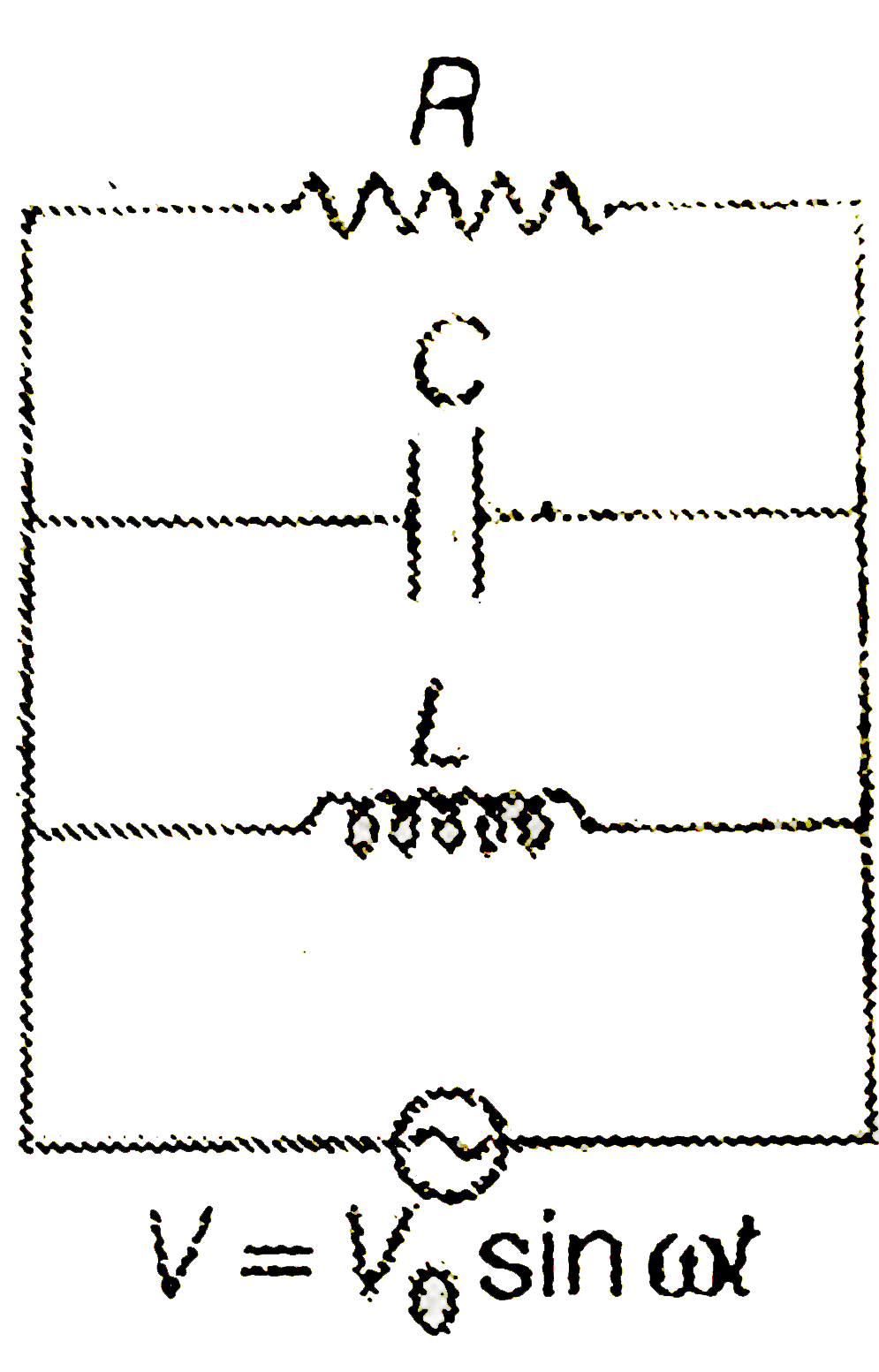Two impedances and when connected separately across a supply consume and at power factor of lagging and leading respectively. If these impedances are now connected in series across the same supply, find
(a) total power absorbed and overall power factor
(b) the value of reactance to be added in series so as to raise the overall power factor to unity.
The correct Answer is:A, B, D
To solve the problem step by step, we will break it down into parts (a) and (b) as specified in the question.
Part (a): Total Power Absorbed and Overall Power Factor
1. Calculate Impedance Z1 for the first impedance (inductor):
- Given: Power P1=100W, Voltage V=230V, Power Factor pf1=0.5 (lagging).
- The formula for power is:
P=V⋅I⋅pf
- Rearranging gives:
I1=P1V⋅pf1=100230⋅0.5=100115≈0.8696A
- Now, using Ohm's law:
Z1=VI1=2300.8696≈264.5Ω
2. Calculate Resistance R1 and Reactance XL for Z1:
- Using the relationship pf=RZ:
R1=pf1⋅Z1=0.5⋅264.5≈132.25Ω
- Now calculate XL:
Z21=R21+X2L⟹XL=√Z21−R21=√(264.5)2−(132.25)2≈229Ω
3. Calculate Impedance Z2 for the second impedance (capacitor):
- Given: Power P2=60W, Power Factor pf2=0.6 (leading).
- Calculate current I2:
I2=P2V⋅pf2=60230⋅0.6=60138≈0.4348A
- Calculate Z2:
Z2=VI2=2300.4348≈529Ω
4. Calculate Resistance R2 and Reactance XC for Z2:
- Calculate R2:
R2=pf2⋅Z2=0.6⋅529≈317.4Ω
- Now calculate XC:
Z22=R22+X2C⟹XC=√Z22−R22=√(529)2−(317.4)2≈423.2Ω
5. Calculate Total Resistance and Reactance in Series:
- Total Resistance Rtotal=R1+R2=132.25+317.4≈449.65Ω
- Total Reactance Xtotal=XC−XL=423.2−229≈194.2Ω
6. Calculate Total Impedance Ztotal:
- Using:
Ztotal=√R2total+X2total=√(449.65)2+(194.2)2≈489.79Ω
7. Calculate Overall Power Factor:
- Power Factor pftotal=RtotalZtotal=449.65489.79≈0.92
8. Calculate Total Power Absorbed:
- Total Power Ptotal=V⋅Itotal⋅pftotal
- First, find Itotal:
Itotal=VZtotal=230489.79≈0.469A
- Now calculate Ptotal:
Ptotal=230⋅0.469⋅0.92≈99W
Part (b): Value of Reactance to Raise Power Factor to Unity
1. Condition for Unity Power Factor:
- For unity power factor, Z=R, which means:
Rtotal=√R2total+(XC−XL+X′L)2
- Where X′L is the new inductive reactance to be added.
2. Set up the equation:
- Rearranging gives:
XC−XL+X′L=0⟹X′L=XL−XC
- Substitute the values:
X′L=194.2Ω
Final Answers:
(a) Total Power Absorbed: 99 W, Overall Power Factor: 0.92
(b) Value of Reactance to be added: 194.2 Ω
- Given: Power P1=100W, Voltage V=230V, Power Factor pf1=0.5 (lagging).
- The formula for power is:
P=V⋅I⋅pf
- Rearranging gives:
I1=P1V⋅pf1=100230⋅0.5=100115≈0.8696A
- Now, using Ohm's law:
Z1=VI1=2300.8696≈264.5Ω
- Using the relationship pf=RZ:
R1=pf1⋅Z1=0.5⋅264.5≈132.25Ω
- Now calculate XL:
Z21=R21+X2L⟹XL=√Z21−R21=√(264.5)2−(132.25)2≈229Ω
- Given: Power P2=60W, Power Factor pf2=0.6 (leading).
- Calculate current I2:
I2=P2V⋅pf2=60230⋅0.6=60138≈0.4348A
- Calculate Z2:
Z2=VI2=2300.4348≈529Ω
- Calculate R2:
R2=pf2⋅Z2=0.6⋅529≈317.4Ω
- Now calculate XC:
Z22=R22+X2C⟹XC=√Z22−R22=√(529)2−(317.4)2≈423.2Ω
- Total Resistance Rtotal=R1+R2=132.25+317.4≈449.65Ω
- Total Reactance Xtotal=XC−XL=423.2−229≈194.2Ω
- Using:
Ztotal=√R2total+X2total=√(449.65)2+(194.2)2≈489.79Ω
- Power Factor pftotal=RtotalZtotal=449.65489.79≈0.92
- Total Power Ptotal=V⋅Itotal⋅pftotal
- First, find Itotal:
Itotal=VZtotal=230489.79≈0.469A
- Now calculate Ptotal:
Ptotal=230⋅0.469⋅0.92≈99W
- For unity power factor, Z=R, which means:
Rtotal=√R2total+(XC−XL+X′L)2
- Where X′L is the new inductive reactance to be added.
- Rearranging gives:
XC−XL+X′L=0⟹X′L=XL−XC
- Substitute the values:
X′L=194.2Ω
(a) Total Power Absorbed: 99 W, Overall Power Factor: 0.92
(b) Value of Reactance to be added: 194.2 Ω
Topper's Solved these Questions
- ALTERNATING CURRENTBOOK - DC PANDEY ENGLISHCHAPTER - ALTERNATING CURRENTEXERCISE - JEE MAIN
62 Videos
- ALTERNATING CURRENTBOOK - DC PANDEY ENGLISHCHAPTER - ALTERNATING CURRENTEXERCISE - Level 2 Comprehension
6 Videos
- ATOMSBOOK - DC PANDEY ENGLISHCHAPTER - ATOMSEXERCISE - MEDICAL ENTRANCES GALLERY
42 Videos
Similar Questions
If two bulbs of power 60 W and 100 W respectively each rated 110 V are connected in series with the supply of 220 V, then
View SolutionTwo bulbs consume the same power when operated at 200 V and 300 V respectively. When these bulbs are connected in series across a DC source of 400 V, then the ratio of power consumed across them is
View SolutionIf two bulbs of 25 W and 100 W rated at 200 volts are connected in series across a 440 volts supply, then
View SolutionWhen three identical bulbs of 60W,200V rating are connected in series to a 200V supply, the power drawn by them will be
View SolutionIn a series LCR circuit, the total reactance is 4Ω and resistance is 3Ω . Its power factor is
View SolutionWhen electric bulbs of same power, but different marked voltage are connected in series across the power line, their brightness will be :
View SolutionA circuit takes a current of 3A at a power factor of 0.6 lagging when connected. to a 115V−50Hz supply. Another circuit takes a current of 5A at a power factor of 0.707 leading when connected to the same supply. If the two circuits are connected in series across a 230V,50Hz supply, then calculate
(a) the current
(b) the power consumed and (c) the power factor
View SolutionA series circuit has an impendence of 50.0Ω and a power factor of 0.63 to 60Hz. The voltage lags the current. To raise the power factor of the circuit

View SolutionAn electric bulb marked 25 W and 100 V is connected across 50 V supply . Now its power is .
View SolutionIf two bulbs, both of rated power 100 W at 220 V, are connected in series with a 220 V supply, the total power consumed by the bulbs will be:
View Solution
